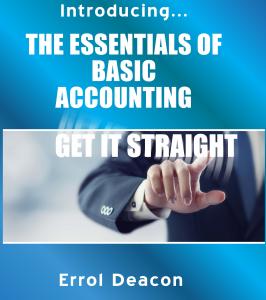
— Errol Deacon
NEW YORK, NEW YORK, UNITED STATES, June 27, 2024 /EINPresswire.com/ — Book 1: Despite “Accounting is the Language of Business.”
Financial accounting is based on historical events, converted into currency. Management accounting deals with the here and now. It extracts the basic information from financial accounting. The 3Q’s: The quality of the reports depends on the quality of the input and the quality of the management of the input
Introducing other real world issues: US Bankruptcy, IRS settlement programs and audits and Intellectual Property (Copyrights, Patents, Trademarks and Trade Secrets) This may incentivise to “get moving” or it might disincentivise. Cool the excitement or the despondency until you have consulted with legal counsel.
The balance sheet and the income statement cover a wealth of information (22 pages) Before entering this arena, there’s a short history of accounting, definitions, cash and accrual accounting, accounting principles and the workings of debit and credits. Accountants, bookkeepers and students need to know this “inside out”
Transactions extend from capitalizing a fictitious corporation and ending with the financial statements which are extracted from the Adjusted Trial Balance. Heathy Living is a hybrid, a storefront holding inventory for sale and income from renting meeting space. Exhibits are a plenty. Advanced readers, may accelerate through that section without losing the overall topic. Check points confirm the accuracy. Dedicated chapters on depreciation, inventory costs and long-term contracts show there is more than one method. The methods selected have different outcomes.
Entities: Small businesses in the US typically elect Sub-S status. Later ownership may consider other options. (Regular corporation, etc) Other topics: Founders shares, preferred and ordinary shares, share class structure, etc.
U.S. Bankruptcy: (Chapter’s 7,9,11, 13 and 15) covers 26 pages, more than a short introduction to an extremely complex subject demanding legal counsel.
IRS Loan programs and IRS Audits: IRS programs vary in complexity and approval rates. Often individuals begin and end this process on their own. Considering the filing costs, the time wasted if the IRS declines the petition on a technicality, it’s recommended engaging a professional, to review and offer advice before submitting the applications. IRS Tax Audits covers among others, the types of audit, audit statute of limitations, how the audit is conducted, rights and duties for both parties, appealing the decision through the IRS and an insight on whether the U.S. Tax Court is a viable option.
Copyrights, Patents, Trademarks and Trade Secrets. The US doesn’t have monopoly here. Among others The Patent Cooperation Treaty and the Paris Convention. What qualifies for a Federally registered trademark? How to maintain the mark? What is a common law trademark? The United States Patent and Trademark Office considers trade secrets as a type of Intellectual Property. A trade secret may be preferable over a patent. Be aware, trade secrets can be unintentionally lost. . For full coverage: http://www.deaconpress.com
Book 2: Introducing the Essentials of Basic Accounting Get it Straight: (80 pages)
Mention “essentials” to ten individuals and you may get ten different opinions depending on the subject. The book is 80 pages. It’s about right for the target market.
These essentials will suffice for students, small business owners, managers, etc (enrolled or considering Accounting 101) Often, within the small business area, due to insufficient knowledge on the owners’ part, the bookkeeper controls the roost telling the owner and management whatever they want.
Experience an immediate increase in ROI (Return on Investment) on professional fees paid. The accountant will be relieved from explaining countless times the basic concepts. They may have given up on this as they figure they aren’t compensated. Replace the constant explaining with improved communication. Small business loan officers gain an insight into what’s behind the figures. Across the board, it’s likely to induce the motivation to pursue advanced courses having passed the stage that accounting is boring and the basics require a thorough knowledge of mathematics and algebra.
Topics, what makes up the balance sheet? What’s an account, General Ledger, journal entry, adjusting journal entries, deferred expenses, customer advances, subscriptions, depreciation, cost of sales, inventory methods. IFRS (International Financial Reporting Standards) is the reporting standard for more than 140 countries. While convergence between US GAAP and IFRS is ongoing there will always be differences. Where applicable, US GAAP and IFRS are addressed. US GAAP is rules based vs. IFRS principles based. Finally, thirteen financial ratios defined and how they are calculated. Other essentials, For full coverage: http://www.deaconpress.com
Libraries and independent bookstores are invited to catalogue both books available through www:deaconpress.com at discounted from the list price or through publishdrive.com. . List Prices: Introducing the Essentials of Basic Accounting Get it Straight (Color) Paperback $23.00, Hardcover $38.00.
Financial Accounting, Corporate Structure, US Bankruptcy, US IRS Debt Relief, IRS Audit, Copyright, Patents, Trademarks Trade Secrets Get it Straight Paperback $40.00,Hardcover $45.00
E-books are available through Amazon, Apple and Ingramspark. The softcover is available through Amazon and publishdrive.com. The hardcover is available through http://www.deaconpress.com
Errol Deacon
Deacon Media Company Inc
[email protected]
Interview with Brightside
![]()
Originally published at https://www.einpresswire.com/article/722788492/released-financial-accounting-corporate-structure-u-s-bankruptcy-introducing-the-essentials-of-basic-accounting





